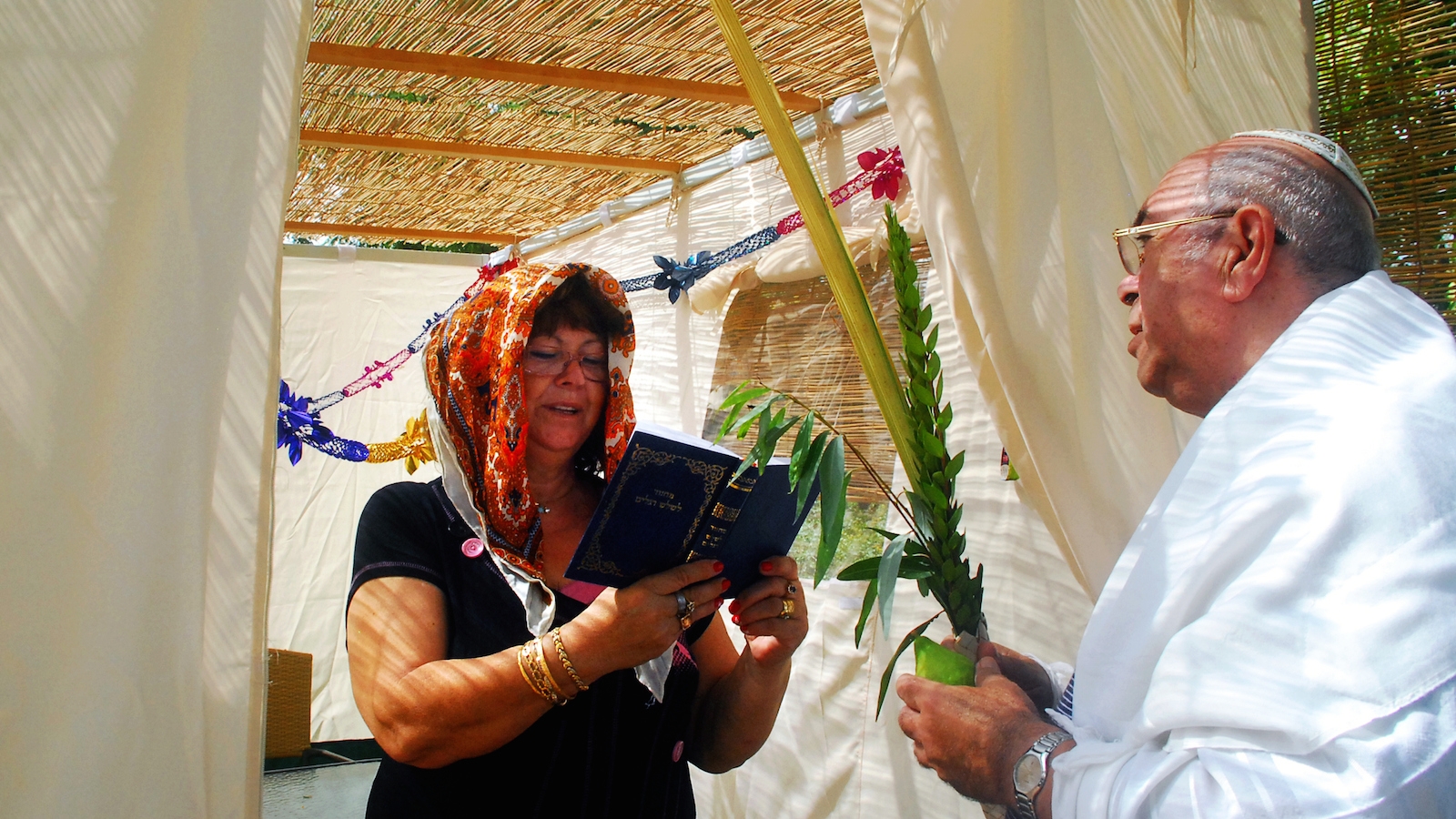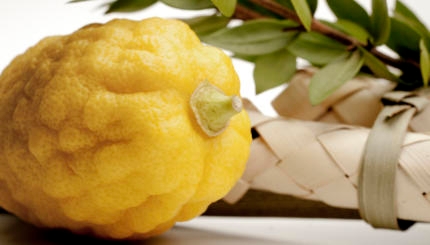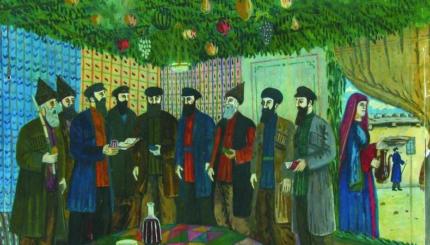It is a positive commandment from the Torah [Leviticus 23:40] to gather together the Four Species during Sukkot:
On the first day you shall take the product of hadar trees, branches of palm trees, boughs of leafy trees, and willows of the brook, and you shall rejoice before Adonai your God seven days.
“The first day” refers to the first day of Sukkot. “Fruit of goodly trees” refers to the etrog (citron). “Branches of palm trees” refers to the lulav. “Boughs of leafy trees” refers to the myrtle (hadasim). “Willows of the brook” refers to the aravot or hoshanot.
The four are often referred to under the inclusive term lulav, since the lulav is the largest and most prominent of the species. Thus, while the mitzvah is to wave the lulav, this actually refers to waving all four species: palm, willow, myrtle and etrog. Also, when people refer to the lulav and etrog, they are referring to all four species, including the willow and myrtle.
How the Four Fit Together
The lulav is a single palm branch and occupies the central position in the grouping. It comes with a holder-like contraption (made from its own leaves) which has two extensions. With the backbone (the solid spine) of the lulav facing you and this holder in place near the bottom, two willow branches are placed in the left extension and three myrtle branches are placed in the right. The myrtle should extend to a greater height than the willows.
With your help, My Jewish Learning can provide endless opportunities for learning, connection and discovery.
This whole cluster is held in the right hand, the etrog is held in the left, and the two should be touching one another. Some have the custom of picking up the etrog first and then the lulav — reversing the order when putting them down–because the etrog is referred to before the others in the biblical verse.
Waving the Lulav
It is a mitzvah to wave the lulav on each of the first seven days of Sukkot. The proper time is in the morning — either before the morning service or during the service immediately before the Hallel. A meditation (found in the Siddur, or prayer book) is recited prior to the blessing (this has many kabbalistic secrets concealed within it).
Blessing for Waving the Lulav
Read the Hebrew text of the blessing on Sefaria.
“Blessed are You, Lord our God, King of the Universe, who has sanctified us with His commandments and has commanded us concerning the waving of the lulav.”
Barukh atah Adonai Eloheinu melekh ha’olam asher kid’shanu b’mitzvotav v’tzivanu al netilat lulav.
On the first day of waving add:
“Blessed are You, Lord our God, King of the Universe, who has granted us life, sustenance, and permitted us to reach this season.”
Barukh atah Adonai Eloheinu melekh ha’olam shehehiyanu v’kiyemanu v’higiyanu lazman hazeh.
After the Blessing
Before the blessing, the etrog is held with its pitom (stemlike protrusion) pointed downward. After the blessing, it is inverted so that the pitom faces up. At this point you wave/shake the lulav (together with the other three) in the following manner:
1. Stand facing east.
2. Hold the lulav out to the east (in front of you) and shake it three times. Each time the motion of shaking should be a drawing in to you–reach and draw in, reach out and draw in, reach out and draw in.
3. Repeat the same motion three times to your right (south), behind over your shoulder (west), to your left (north), raising it up above you, lowering it down below you.
4. All of these should be done slowly and deliberately–concentrating on the symbolisms and intentions of the act. The lulav is also waved during Hallel while saying: “Give thanks to the Lord for He is good, for His lovingkindness endures forever.”
Hodu – shake front [East]
L’Adonai – [never shake when saying God’s name]
Ki – shake right [South]
Tov – shake back [West]
Ki – shake left [North]
Le-olam – shake up
Chasdo – shake down
This verse occurs twice during Hallel.
The lulav is again waved while saying: “Let Israel say that His lovingkindness endures forever.”
Yomar – shake front [East]
Na – shake right [South]
Yisrael – shake back [West]
Ki – shake left [North]
Le-olam – shake up
Chasdo – shake down
And it is waved again while saying: “We implore You, Lord, save us.”
A-na – [Shake front/East on first syllable, shake right/South on second syllable]
Adonai – [never shake when saying God’s name]
Ho-shi-ah [Shake back/West first syllable, shake left/North second syllable, shake up last syllable]
Na – shake down
The lulav and etrog are traditionally not waved on Shabbat because bringing these items to the synagogue would violate the prohibition against carrying. Some liberal synagogues do wave the lulav and etrog on Shabbat. While it is customary for each individual to have a lulav and etrog, many synagogues leave some sets in the synagogue sukkah for the use of their members. The lulav and etrog may also be waved at home.
Reprinted with permission from The Jewish Catalog: A Do-It-Yourself Kit, edited by Richard Siegel, Michael Strassfeld, and Sharon Strassfeld, published by the Jewish Publication Society.
Adonai
Pronounced: ah-doe-NYE, Origin: Hebrew, a name for God.
etrog
Pronounced: ETT-rahg, Origin: Hebrew, a citron, or large yellow citrus fruit that is one of four species (the others are willow, myrtle and palm) shaken together as a ritual during the holiday of Sukkot.
lulav
Pronounced: LOO-lahv (oo as in boo), Origin: Hebrew, a bundle of branches representing three species -- willow, myrtle and palm -- which are shaken together with the etrog on Sukkot.
mitzvah
Pronounced: MITZ-vuh or meetz-VAH, Origin: Hebrew, commandment, also used to mean good deed.
sukkah
Pronounced: SOO-kah (oo as in book) or sue-KAH, Origin: Hebrew, the temporary hut built during the Harvest holiday of Sukkot.
Sukkot
Pronounced: sue-KOTE, or SOOH-kuss (oo as in book), Origin: Hebrew, a harvest festival in which Jews eat inside temporary huts, falls in the Jewish month of Tishrei, which usually coincides with September or October.
Torah
Pronunced: TORE-uh, Origin: Hebrew, the Five Books of Moses.


